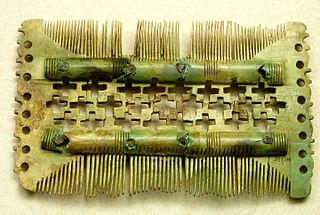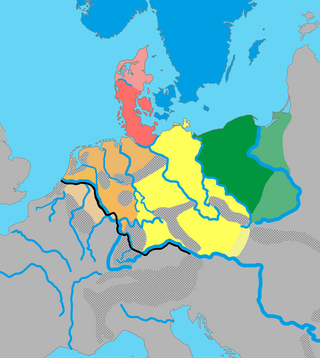
The Angles were one of the main Germanic peoples who settled in Great Britain in the post-Roman period. They founded several kingdoms of the Heptarchy in Anglo-Saxon England. Their name, which derives from the Anglia Peninsula, is the root of the name England. According to Tacitus, writing around 100 AD, a people known as Angles (Anglii) lived east of the Lombards and Semnones, who lived near the Elbe river.

The Suebi or Suebians were a large group of Germanic peoples originally from the Elbe river region in what is now Germany and the Czech Republic. In the early Roman era they included many peoples with their own names such as the Marcomanni, Quadi, Hermunduri, Semnones, and Lombards. New groupings formed later, such as the Alamanni and Bavarians, and two kingdoms in the Migration Period were simply referred to as Suebian.

The Irminones, also referred to as Herminones or Hermiones, were a large group of early Germanic tribes settling in the Elbe watershed and by the first century AD expanding into Bavaria, Swabia, and Bohemia. Notably this included the large sub-group of the Suevi, that itself contained many different tribal groups, but the Irminones also included for example the Chatti.

The Thuringii, Toringi or Teuriochaimai were an early Germanic people that appeared during the late Migration Period in the Harz Mountains of central Germania, a region still known today as Thuringia. It became a kingdom, which came into conflict with the Merovingian Franks, and it later came under their influence and Frankish control. The name is still used for one of modern Germany's federal states (Bundesländer).

The Teutons were an ancient northern European tribe mentioned by Roman authors. The Teutons are best known for their participation, together with the Cimbri and other groups, in the Cimbrian War with the Roman Republic in the late second century BC.

The Istvaeones were a Germanic group of tribes living near the banks of the Rhine during the Roman Empire which reportedly shared a common culture and origin. The Istaevones were contrasted to neighbouring groups, the Ingaevones on the North Sea coast, and the Herminones, living inland of these groups.

The Hermunduri, Hermanduri, Hermunduli, Hermonduri, or Hermonduli were an ancient Germanic tribe, who occupied an inland area near the source of the Elbe river, around what is now Bohemia from the first to the third century, though they have also been speculatively associate with Thuringia further north. According to an old proposal based on the similarity of the names, the Thuringii may have been the descendants of the Hermunduri. At times, they apparently moved to the Danube frontier with Rome. Claudius Ptolemy mentions neither tribe in his geography but instead the Teuriochaemae, who may also be connected to both.

The Semnones were a Germanic and specifically a Suevian people, who were settled between the Elbe and the Oder in the 1st century when they were described by Tacitus in Germania:
"The Semnones give themselves out to be the most ancient and renowned branch of the Suevi. Their antiquity is strongly attested by their religion. At a stated period, all the tribes of the same race assemble by their representatives in a grove consecrated by the auguries of their forefathers, and by immemorial associations of terror. Here, having publicly slaughtered a human victim, they celebrate the horrible beginning of their barbarous rite. Reverence also in other ways is paid to the grove. No one enters it except bound with a chain, as an inferior acknowledging the might of the local divinity. If he chance to fall, it is not lawful for him to be lifted up, or to rise to his feet; he must crawl out along the ground. All this superstition implies the belief that from this spot the nation took its origin, that here dwells the supreme and all-ruling deity, to whom all else is subject and obedient. The fortunate lot of the Semnones strengthens this belief; a hundred cantons are in their occupation, and the vastness of their community makes them regard themselves as the head of the Suevic race."

The Chamavi, Chamãves or Chamaboe (Χαμαβοί) were a Germanic tribe of Roman imperial times whose name survived into the Early Middle Ages. They first appear under that name in the 1st century AD Germania of Tacitus as a Germanic tribe that lived to the north of the Lower Rhine. Their name probably survives in the region today called Hamaland, which is in the Gelderland province of the Netherlands, between the IJssel and Ems rivers.
The Reudigni were one of the Nerthus-worshipping Germanic tribes mentioned by Tacitus in Germania. Schütte suggests that the name should be read Rendingi or Randingi and then the name would be the same as the Rondings of Widsith. They have otherwise been lost to history, but they may have lived in Denmark prior to the arrival of the Daner recorded by Jordanes. Schütte suggests that their name lives on in the names Randers and Randers Fjord, Denmark.
(Original Latin) "Reudigni deinde et Aviones et Anglii et Varini et Eudoses et Suardones et Nuithones fluminibus aut silvis muniuntur. Nec quicquam notabile in singulis, nisi quod in commune Nerthum, id est Terram matrem, colunt eamque intervenire rebus hominum, invehi populis arbitrantur. ..." --Tacitus, Germania, 40.
(English translation) "There follow in order the Reudignians, and Aviones, and Angles, and Varinians, and Eudoses, and Suardones and Nuithones; all defended by rivers or forests. Nor in one of these nations does aught remarkable occur, only that they universally join in the worship of Herthum (Nerthus); that is to say, the Mother Earth."--Tacitus, Germania, 40, translated 1877 by Church and Brodribb.
The Aviones or Auiones were one of the Nerthus-worshipping Germanic tribes of the 1st century mentioned by Tacitus in Germania, and they lived either in the southern Jutland Peninsula, or on Öland. They are mentioned in Widsith as Eowan.
The Suarines or Suardones were one of the Nerthus-worshipping Germanic tribes mentioned by Tacitus in Germania. They have otherwise been lost to history, but Schütte suggests that their name lives on in the name of the town Schwerin.

The Dulgubnii are a Germanic tribe mentioned in Tacitus' Germania as living in what is today northwest Germany. Tacitus describes them being to the north of the Angrivarii and Chamavi, and as having moved from the north into the area once belonging to the Bructeri, between Ems, Lippe, and Weser. In this same area as the Dulgubnii, north of the Chamavi and Angrivarii, were the Chasuarii, and north of these, on the North Sea coast, where the Chauci. The Chasuarii's name is thought to derive from the River Hase which feeds into the middle of the Ems from the east, just northwest of the area associated with the Angrivarii, on the Weser. So from Tacitus, it appears that the Dulgubnii probably lived near the Weser.
The Gutones were a Germanic people who were reported by Roman era writers in the 1st and 2nd centuries to have lived in what is now Poland. The most accurate description of their location, by the geographer Ptolemy, placed them east of the Vistula River.

The Frisii were an ancient tribe, living in the low-lying region between the Rhine–Meuse–Scheldt delta and the River Ems, sharing some cultural and linguistic elements with the neighbouring Celts. The newly formed marshlands were largely uninhabitated until the 6th or 5th centuries BC, when inland settlers started to colonize the area. As sea levels rose and flooding risks increased, the inhabitants learned to build their houses on village mounds or terps. The way of life and material culture of the Frisii hardly distinguished itself from the customs of the Chaucian tribes living farther east. The latter, however, were considered to be part of the Germanic tribal confederation.

Elbe Germanic, also called Irminonic or Erminonic, is a term introduced by the German linguist Friedrich Maurer (1898–1984) in his book, Nordgermanen und Alemanen, to describe the unattested proto-language, or dialectal grouping, ancestral to the later Lombardic, Alemannic, Bavarian and Thuringian dialects. During late antiquity and the Middle Ages, its supposed descendants had a profound influence on the neighboring West Central German dialects and, later, in the form of Standard German, on the German language as a whole.

For around 450 years, from around 55 BC to around 410 AD, the southern part of the Netherlands was integrated into the Roman Empire. During this time the Romans in the Netherlands had an enormous influence on the lives and culture of the people who lived in the Netherlands at the time and (indirectly) on the generations that followed.
The Germani cisrhenani, or "Left bank Germani", were a group of Germanic peoples who lived west of the Lower Rhine at the time of the Gallic Wars in the mid-1st century BC.
The Lex Thuringorum is a law code that survives today in one 10th-century manuscript, the Codex Corbeiensis, alongside a copy of the Lex Saxonum, the law of the Saxons. The code was compiled in the first decade of the 9th century, probably 802–3, under Frankish patronage. The language of the law code is Latin and few Thuringians could have read it, nonetheless some must have cooperated with Frankish officials during the process of collecting and codifying the customs. The Lex Thuringorum, the Lex Saxonum, the Lex Francorum Chamavorum and the Lex Frisionum comprise the four so-called "Carolingian tribal laws", because they were produced at the same time at the direction of King Charles I in order to accommodate the differing legal customs of the nations living within his empire. They were neither totally faithful nor comprehensive reproductions of tribal law, but were created as part of a process of official christianisation. The historian Timothy Reuter writes that "the manuscript transmission does not suggest that [the Thuringian law] was extensively used, though there are enough different strata of law still visible in the text to suggest that it was not merely a literary exercise."








